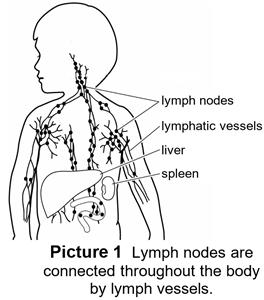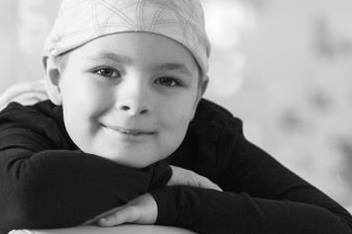Hodgkin Lymphoma
![]()
Hodgkin lymphoma is a form of cancer of the lymphatic system. The cause is not known. The lymphatic system fights infection and is a part of the circulatory system. It contains hundreds of

lymph nodes. One lymph node is about the size of a kidney bean. Nodes are connected by lymph vessels throughout the body (Picture 1).
Lymph is a clear fluid that carries infection-fighting cells through the nodes and vessels. The lymph nodes make lymphocytes, a type of white blood cell that keeps infections from spreading. They also keep out germs that cause infections.
Signs and Symptoms
- Your child could experience fever, weight loss, and heavy sweating at nights.
- Lymph nodes are in different areas of the body. When a lymph node gets large and swollen, it is often called a lump. They are usually not painful. A lump could appear:
- On the side of the neck
- Under the arm in the armpit
- Between the thigh and torso (groin)
- In the chest - found by having an X-ray or CT scan
Diagnosis
A health care provider will examine the lymph node to diagnosis Hodgkin lymphoma.
- The node, or a small piece of the node, is taken out in an operating room. Your child will be under general anesthesia or sedated. After the lymph node tissue is removed, it will be examined. This is called a biopsy.
- This type of cancer can spread to other parts of the body through the bloodstream. It may affect the liver, bones, lung tissue, or the nervous system.
- Once a diagnosis is made, more tests may be needed. Tests can include: MRI, PET and CT scan, blood tests, chest X-ray, or bone marrow biopsy.
Staging
Staging describes how much and where the disease is at the time of diagnosis.
- Stage I (1) – Only one tumor area or organ is involved.
- Stage II (2) – Tumor is in 2 or more places above the large, flat muscle that divides the chest and abdomen (belly). This muscle is called the diaphragm.
- Stage III (3) – Tumor is in lymph node areas on both sides (above and below) the diaphragm.
- Stage IV (4) – Tumor is found outside the lymphatic system in places like the liver, bone marrow, lungs, bone, or the central nervous system (CNS). The CNS includes the brain and spinal cord.
When your child is given a stage number for Hodgkin lymphoma, they will also get a letter (A or B) depending on whether or not they have certain symptoms:
- A – there are no symptoms like fever, night sweats, or weight loss
- B – there are symptoms like fever, night sweats, or weight loss
Treatment
Children with Hodgkin lymphoma are treated with radiation therapy, chemotherapy, or both. The type of treatment depends on the stage of the disease. Treatment may last 6 to 8 months. Your child’s oncologist (cancer doctor) will talk to you about treatment.
- Radiation therapy is typically at The Arthur G. James Cancer Hospital at The Ohio State University, but may be available at other centers.
- Chemotherapy and check-ups are at Nationwide Children’s Hospital Hematology/Oncology Clinic, Infusion Clinic, or as a patient in the hospital.
- Your child’s blood count is checked often. This is to make sure white blood cells, hemoglobin, and platelet counts are normal.
Follow-Up
- Your child will see an oncologist who will monitor their progress. They will also have scans periodically to see how well the treatment is working.
If you have any questions, ask your child’s health care provider.
HH-I-126 6/90, Revised 1/22 Copyright 1990-2022, Nationwide Children’s Hospital


